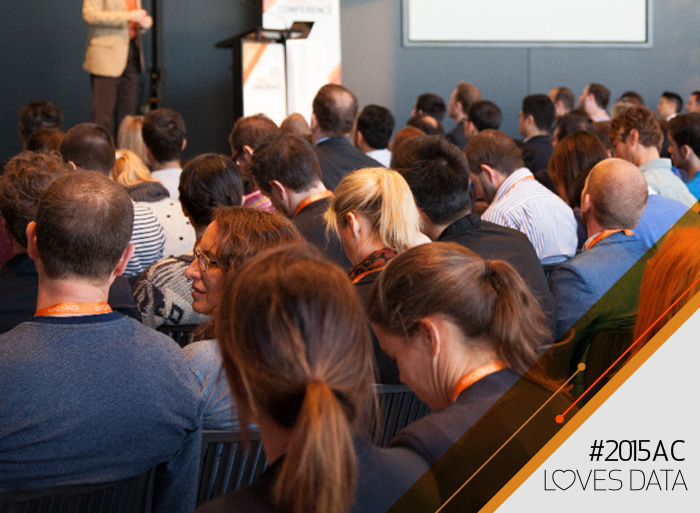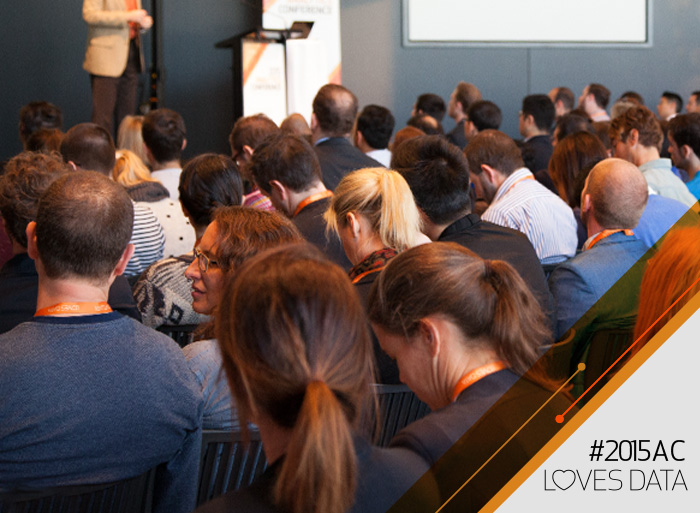5 Ways to be Successful at Analytics as Told by Industry Experts
Loves Data

The 2015 Analytics Conference's Top tips and Best Takeaways
That’s a wrap! It’s been another delightful year and we’ve had a blast bringing the Analytics Conference Down Under (that makes it four times since 2012). In that time, we’ve shared some great insights from some of the biggest thought leaders in analytics. This year we delivered a keynote from the godfather of digital analytics, Jim Sterne, as well as Googlers Krista Seiden and Mike Kwong. They were joined by advocates Simo Ahava and Tim Wilson, data viz expert Lea Pica and many more captivating speakers. Here’s a quick wrap up of the best ideas, top tips and key takeaways from #2015AC.
We sold out again this year, so make sure you join our Conference updates for alerts when we release next year’s tickets.
1. Become indispensable
As analytics professionals, becoming indispensable to your organisation is what we should strive for. To do this, understand the data and the ‘raw material’. Pull it all together using the right tools, and then get creative with the data to uncover new insights and add value. It’s important to create data models to help you form a process. Jim Sterne mentions that not all models were created equal – all models are wrong but some models are useful! Use models that are doing the job, but don't cling on to them beyond their usefulness.
Importantly: when it comes to communicating your results, repeat a story not a number. Telling a story means your analysis becomes meaningful and in concluding your story, you can tie it back to the company’s KPIs. Our job is not to merely report but to have an opinion and be specific.
2. Don’t suck at testing
Google Analytics Advocate, Krista Seiden, gave the audience a lot of great tips when it comes to testing. She notes that there is a difference between testing and analysis – not everything is a test. When testing, it is vital to control everything except the variable being tested. Before your test begins, you need to have decided on test criteria, and this criteria must be agreed on by the technical and marketing teams (testing and teamwork go hand-in-hand).
Chris Samila from Optimizely suggests making your objective measurable (such as a rate or ratio), as well as something that is linked to user behaviour and attributable to revenue (for example the completion rate for a particular form).
The cycle is simple: hypothesis → test → learn → repeat. The execution will be the most challenging.
3. Eliminate death by PowerPoint
Why do bad things happen to good data? When it comes to delivering results, presentations are an analyst’s much-used tool. However, it’s important to make the data on your slides stand out. To avoid death by presentation, be your audience: put yourself in their shoes. Do they really want to see ten slides of statistics?
Data viz expert Lea Pica thinks we should be getting rid of bullet points – creating ideas not slides. By resisting the fluff, and never (ever) using Clipart, we should all create compelling presentations that actually tell a story. Using data visuals such as graphs and charts are great, but choose the right one and avoid pie charts. Why does the pie get the chop? Our simple human brains can’t process the difference in the segments, and find it easier to absorb the differences in column heights.
4. Resist plug-and-play analytics
Most of us are guilty of committing this one: using the default dashboards, reports and implementation that is available in our analytics accounts. If we don’t question their performance and usefulness, we can easily be led into dangerous territory. The golden rule from Simo Ahava: data quality is not a given. Let’s not forget that Google Analytics is designed to suit many different businesses and has not been designed just for yours.
To make your setup useful, the data must be collected and reported in ways that are meaningful to your organisation. Consider your problem and brainstorm ways to fix it. Track more of your users’ behaviour, but only to get data that will answer specific questions. Analyse the data to feed the hypothesis machine for the next cycle of analysis work. Make use of custom dimensions and metrics, and use custom dashboards. Start with the solutions others have come up with – then modify or create and share your own. No one said this would be easy. Data is difficult because it’s supposed to be!
5. Power up to get further in your career
When it comes to your career in digital analytics, there is no single career path. It’s a rapidly changing industry and a relatively new one. People will come from very diverse backgrounds, and you will also have diversity in the backgrounds of those you are hiring. This is great because we each craft a different story from our backgrounds which leads to more creativity, inspiration and innovation. In this engaged community, sharing is always caring so spread knowledge by being a mentor, teacher (even internally in your own organisation), by contributing to the blogosphere, social media and collaborating with others in the industry.
Then there’s what you can gain by learning yourself. Learn from blogs, books (Benjamin Mangold has just released Learning Google Adwords and Google Analytics) and there’s training available, including Google Analytics Academy, and paid training (check out Loves Data’s Google Analytics and Advertising Online courses). Knowledge is always powerful, so learn more to get more.
For more Conference takeaways and great ideas, check out our blog post, ‘6 General Themes From the Analytics Conference We Can Start Applying Immediately’.
2015 Analytics Conference, it’s been wonderful. See you next year for the 2016 Conference.
Now that we’ve listed our top takeaways, what are yours? Leave them in the comments to make this post an even better resource.

Comments